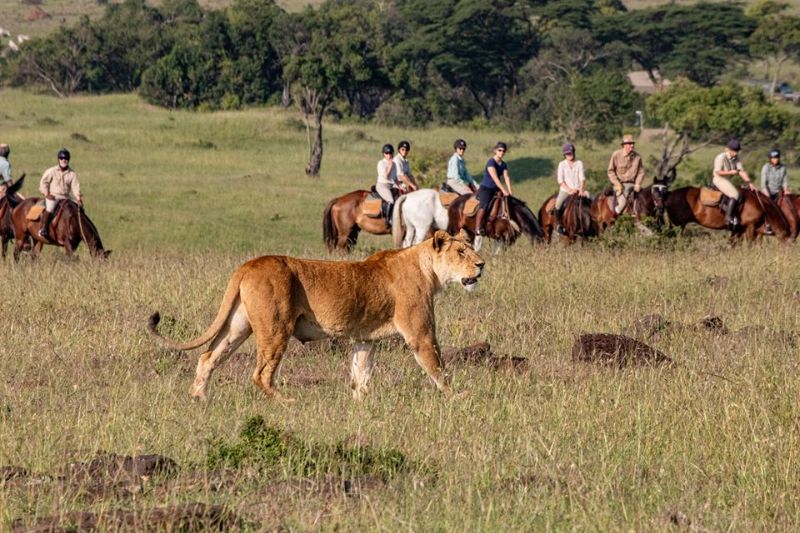
The Ultimate Horseback Safari Experience in Kenya
The Ultimate Horseback Safari Experience in Kenya. Kenya is renowned for its breathtaking landscapes, abundant wildlife, and world-class safari experiences. While traditional game drives are the norm, horseback safaris offer a truly immersive and exhilarating way to explore the wilderness. Imagine galloping alongside zebras, riding quietly past giraffes, and encountering elephants in a way that feels entirely natural—without the noise of a vehicle or the barrier of metal and glass. A horseback safari allows riders to blend seamlessly into the wild, creating an intimate and unforgettable adventure. Whether you’re a seasoned equestrian or an adventurous traveler seeking a fresh perspective, horseback safaris in Kenya provide a one-of-a-kind way to experience the African bush.

Why Choose a Horseback Safari in Kenya?
A horseback safari is unlike any other safari experience. Instead of being confined to a vehicle, riders become part of the landscape, moving in harmony with the wildlife. Horses are non-threatening to animals, allowing for incredibly close encounters that are impossible in a car. Picture yourself cantering across golden plains, feeling the wind rush past as herds of wildebeest move in unison, or standing still as a herd of elephants passes peacefully nearby. The sense of freedom and connection with nature is unparalleled.
Beyond the thrill of the ride, horseback safaris offer exclusivity. These safaris are conducted in private conservancies or remote wilderness areas, away from the crowds, ensuring a more intimate and personalized experience. Whether it’s a half-day excursion or a multi-day journey through Kenya’s wild heart, every ride is led by expert guides who ensure safety while sharing fascinating insights about the land, wildlife, and culture.
Top Destinations for Horseback Safaris in Kenya
Kenya offers diverse landscapes for horseback safaris, ranging from vast open savannahs to lush forests and volcanic hills. The best locations not only provide spectacular scenery but also boast rich wildlife populations, making every ride an adventure.
-
Laikipia Plateau – A Rider’s Paradise
Laikipia is one of Kenya’s premier horseback safari destinations, offering a mix of rugged terrain, rolling hills, and open plains teeming with wildlife. This region is home to elephants, rhinos, lions, and even the rare African wild dog. Riders can explore private conservancies such as Lewa, Borana, and Ol Pejeta, enjoying uninterrupted encounters with nature. Multi-day safaris in Laikipia often involve mobile camps, allowing for deeper exploration of this pristine wilderness.
-
Maasai Mara – Riding Among the Great Migration
For the ultimate adrenaline rush, nothing compares to riding in the Maasai Mara during the Great Migration (July–October). Galloping alongside thousands of wildebeest and zebra as they traverse the plains is a once-in-a-lifetime experience. The Mara’s rolling grasslands provide the perfect terrain for long, exhilarating rides, while the abundance of predators such as lions and cheetahs adds an element of excitement. Private conservancies bordering the Mara, such as Olare Motorogi and Naboisho, offer exclusive riding safaris with fewer tourists.
-
Amboseli & Chyulu Hills – Galloping with Kilimanjaro Views
For those seeking dramatic scenery, the Chyulu Hills near Amboseli National Park provide an unbeatable backdrop. With Mount Kilimanjaro towering in the distance, riders traverse volcanic hills, acacia forests, and vast open plains, often encountering elephants, giraffes, and gazelles along the way. The rolling terrain allows for breathtaking gallops, while the remoteness of the area ensures a peaceful, undisturbed ride.
The Best Time for a Horseback Safari in Kenya
While Kenya is a year-round safari destination, the best time for horseback safaris is during the dry seasons—June to October and December to March. During these months, the grass is shorter, making wildlife easier to spot, and the terrain is firm, providing ideal riding conditions.
For those who dream of experiencing the Great Migration on horseback, visiting between July and October is perfect. However, if you prefer a quieter safari with fewer crowds, consider visiting outside the migration period when the landscapes remain stunning and wildlife sightings are still exceptional.
What to Expect on a Horseback Safari
Horseback safaris can range from a few hours to multi-day expeditions covering vast distances. Multi-day safaris often involve riding between luxury lodges or mobile tented camps set up in the wilderness. Evenings are spent around a campfire, sharing stories under the African night sky, while gourmet meals are prepared by skilled chefs.
The pace of the ride depends on the riders’ skill levels. Beginners can enjoy gentle treks on calm horses, while experienced riders have the opportunity for exhilarating gallops across open plains. Each safari is tailored to the group, ensuring a safe and enjoyable experience for all.
Who Can Join a Horseback Safari?
While horseback safaris are open to most people, they require a moderate level of fitness and confidence in the saddle. Many operators require riders to be comfortable at a trot and canter, especially for longer safaris. Some lodges and conservancies offer beginner-friendly rides, with trained guides assisting those new to horseback adventures. The minimum age for most horseback safaris is around 12 years, though this varies by operator.
Packing Essentials for a Horseback Safari
Packing wisely can enhance the comfort and enjoyment of a horseback safari. Essential items include:
- Riding Helmet – Some lodges provide helmets, but bringing your own ensures a proper fit.
- Comfortable Riding Clothes – Lightweight, breathable fabrics, long-sleeved shirts, and jodhpurs or riding breeches.
- Riding Boots – Sturdy, closed-toe boots with a small heel for stability in the stirrups.
- Gloves – Prevent blisters and improve grip on the reins.
- Sunscreen & Sunglasses – Protection from the African sun is a must.
- Insect Repellent – To guard against mosquitoes and tsetse flies.
- Binoculars & Camera – To capture wildlife sightings and scenic landscapes.

Why Horseback Safaris Are a Must-Do in Kenya
Horseback safaris offer an intimate, adventurous, and eco-friendly way to experience Kenya’s incredible wilderness. Unlike traditional safaris, where vehicles can feel intrusive, riding a horse allows for a more organic connection with the environment. Wildlife reacts differently to horses, often allowing for closer encounters without fear. The freedom of galloping across the savannah, surrounded by untouched landscapes, creates an unmatched sense of adventure.
For those seeking a safari experience that goes beyond the ordinary, horseback safaris in Kenya deliver excitement, exclusivity, and breathtaking beauty. Whether it’s exploring Laikipia’s wild terrain, chasing the Great Migration in the Maasai Mara, or riding against the backdrop of Kilimanjaro, every moment in the saddle promises to be unforgettable.
Related Posts;






